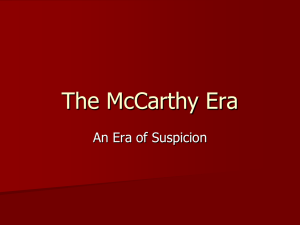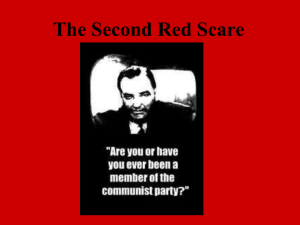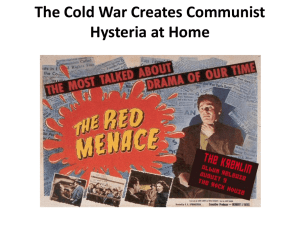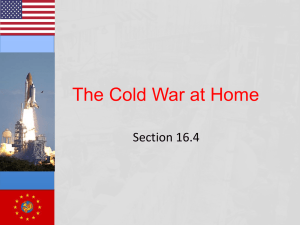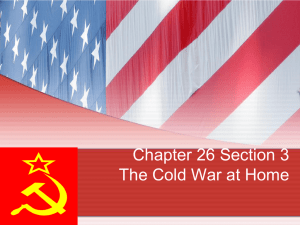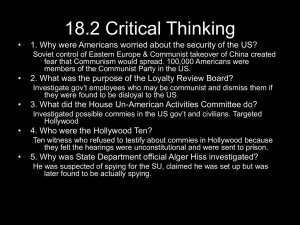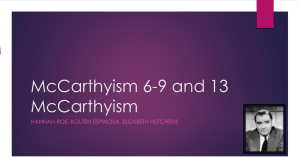AMH Chapter 15 Section 3
advertisement
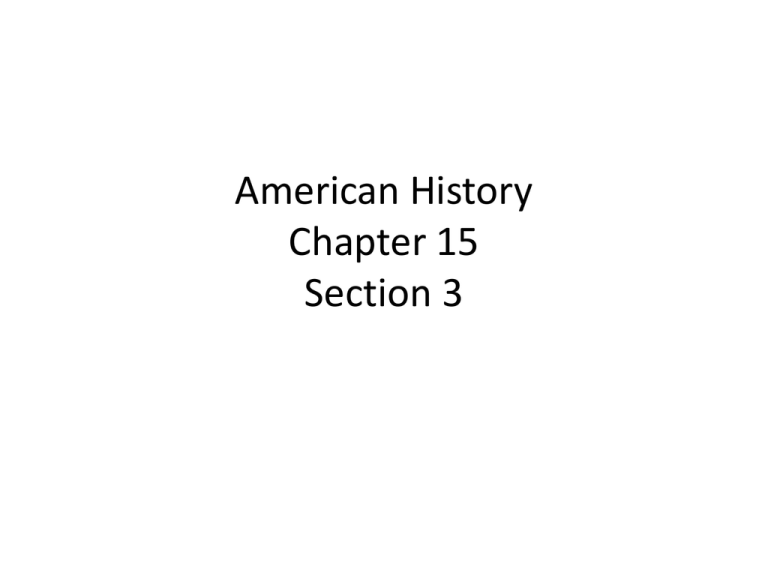
American History Chapter 15 Section 3 Red Scare • During the 1950s, Americans were caught up in the Red Scare. • It began in September 1945 with Soviet defector Igor Gouzenko defected with documents revealing a Soviet effort to infiltrate organizations and government agencies, looking for information about the atomic bomb. What is a “Defector” • A defector is someone who escapes their country for another country (mostly because they are being repressed). • This led to fear of a Communist subversion, subversion is an effort to secretly weaken a society and overthrow its Government. Loyalty Review • In 1947 Truman set up a loyalty review program to screen federal employees to test their loyalty. • Between 1947 and 1951 more than 6 million federal employees were screened for their loyalty to the U.S. government and over 2,000 people lost their jobs. HUAC • The FBI infiltrated groups and wiretapped telephones. • FBI Director J. Edgar Hoover urged the House Un-American Activities Committee (HUAC) to hold public hearings on Communist subversion. SAG • One of the hearings focused on the film industry and Hollywood. • The head of the Screen Actors Guild (union for people in the film industry), Ronald Reagan told HUAC that there were Communist in Hollywood. Many in Hollywood (actors, actress, directors, broadcasters, and screenwriters) were blacklisted because of rumor or they did not provide testimony to HUAC. Blacklisted • When someone is blacklisted, people don’t want to hire them for a job because of their background, they are basically refused work. Hiss Affair • In 1948 Whittaker Chambers, a magazine editor, testified that several government officials were spies. • One the spies was Alger Hiss of the State Department. • Hiss denied this charge, but was later found guilty. • Hiss was also convicted of perjury, or lying under oath. The Rosenbergs • In another case, Ethel and Julius Rosenberg were found guilty of passing along atomic secrets to the Soviets. • The Rosenbergs were convicted and ultimately executed for treason. Evidence later released to the American public showed that the Rosenbergs were indeed guilty. Employers requiring loyalty oaths • The University of California required its faculty members to take loyalty oaths and fired those who refused. • Additionally, the TaftHartley Act of 1947 required Unions leaders to take loyalty oaths that they were not Communist. Which side is winning???? • In 1949 the Red Scare grew worse. – The Soviet Union tested an atomic bomb, and China fell to the Communists. • Many Americans believed that they were losing the Cold War and that Communists had infiltrated the government Senator Joseph McCarthy • In February of 1950, Senator Joseph McCarthy claimed that he had a list of 205 Communists working in the State Department. • He accused many politicians and others of being Communists. • He never produced the list as proof. The Party of Betrayal • McCarthy distributed a booklet called “The Party of Betrayal,” which accused leaders Democratic Party leaders of corruption and protecting Communists. McCarran Act of 1950 • The McCarran Act was passed in 1950. – This law required all Communist organizations to register with the government. • The groups were also forced to share their records with the government. • The law stopped Communists from getting passports or traveling abroad. • It stated that they could be arrested during emergencies. • Truman tried to veto the bill, but Congress overrode the veto. The bill became law. More Investigations • In 1952, after Republicans won control of Congress, McCarthy became chairman of the Senate subcommittee on investigations. • McCarthy forced government officials to testify about Communist influences. Witch Hunts • McCarthy turned the investigations into witch hunts based on weak evidence and fear. • He destroyed reputations with unfounded charges. • This became known as McCarthyism. • McCarthy would badger witnesses and refuse to accept their answers. • His methods left a sense of suspicion and guilt about the witnesses. • People were afraid to challenge him for fear of becoming targets themselves. Questioning the military???? • In 1954 McCarthy began to question members of the United States Army. • McCarthy’s investigation was aired on television, and millions of Americans watched. • McCarthy’s popularity decreased as people finally challenged him and his methods. • In 1954, the Senate passed a vote of censure (formal disapproval) against McCarthy—one of the most serious criticisms it can level against a Senate member. End of McCarthyism • McCarthy’s influence was gone, he faded from public view and died in 1957. • He used the fear of communism to increase his own power and destroy the reputations of many people. Why the Red Scare…scared people • The Red Scare and the spread of nuclear weapons shaped everyday life in the United States during the 1950s. • Americans were upset when the Soviet Union tested the powerful hydrogen, or H-bomb. Prepping • They began to prepare for a surprise Soviet attack. • To protect themselves from a nuclear bomb, some families built backyard fallout shelters and stocked them with canned goods. • Students also practiced bomb drills called “duckand-cover” drills. Not enough protection • Experts warned that these measures would not protect people from the initial blast or the fallout—the radiation left after the blast. • For each person killed by the blast, four more would die from fallout. Influencing Cinema • The fear of communism influenced American movies and fiction. • Worries about nuclear war and Communism fed people's imagination and soon appeared in popular fiction among other media. • Many movies focused on FBI activities in spy cases and novels described the effects of nuclear war.
